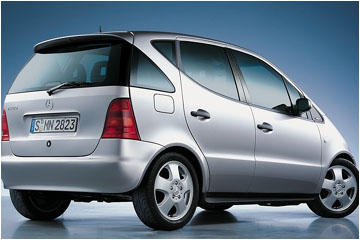 (Image from Mercedes web site)
(Image from Mercedes web site)
 (Image from Mercedes web site)
(Image from Mercedes web site)
Autumn 2000
I tried this car for two reasons. The first was simply that I needed some cheap transport to get me through the first couple of weeks after I arrived back in the UK - until I bought my own car. The second was that I was curious anyway, especially since I'd been reading so much about Mercedes cars recently (while investigating what car to buy myself).
Cheap transport? Yup. EasyRentACar. Very good value for money.
First Impressions
Mondo weirdo. The A-Class looks like a lunar module. It seems this sort of Blake's 7 styling is becoming more common now - previously it was limited to Lamborghini. The shape is also the product of design aims. To keep the wheelbase short while also providing decent accommodation, the engine and gearbox are underneath the passenger compartment. This makes the car tall but does try to keep the weight as low as possible. All angles and planes, and overall, quite cute - certainly not intimidating.
Accommodation
The seats are quite high up, especially in the back where the best is made of cramped legroom by being slightly higher up than the driver. The height makes it dead easy to get into, though - you don't climb up into it like a 4x4, but neither do you need to crouch down like a normal saloon. The seats are essentially at bum-level for the average occupant, and you simply sit down and swivel round.
The interior styling is fairly minimalist - this was the 'Classic', i.e. basic version. Higher specs can include leather seats and so on, but I wonder if the thin, hard plastic on the dash and controls is also improved on - I doubt it. Weight-saving measures include lightweight seats with rather thin padding: they're reasonably comfy at first, but are too hard for longer journeys over 100 miles. The boot is reasonable, in fact quite good for a short car.
Overall, a good effort for such a small vehicle, but limited by space constraints.
Performance
The 1.6 engine in this model was great, providing good mid-range oomph while not being reluctant to rev. I had chosen a manual gearbox, which appears to never be a good decision in a Mercedes, even a fairly new model like this. It was reluctant and slow to change gears, although the light clutch (and other controls) made the best of it. The ratios were good, though, including a fairly tall fifth for surprisingly civilised motorway cruising.
The light weight, combined with the punchy engine throbbing away under your feet, makes for surprisingly good progress, and I had no problem cracking the ton. I'm sure that at higher autobahn speeds, though, the tall shape and smallish engine would limit the high-speed cruising potential. Lightweight cars are like that: great at low speeds, but limited eventually by simple lack of power when aerodynamics, rather than power-to-weight ratio, becomes the dominant factor. This is true of all lightweight cars, from a Renault 5 to a Lotus Elise.
The low weight certainly helps with fuel economy though, and you can't fault it there.
Handling
The tall shape and tiny wheelbase of this car mean it was never going to handle well. Famously, a pre-production model failed the 'elk test' - a high-speed swerve caused it to topple over. Mercedes were forced into an embarrassing redesign at the last minute.
Grip isn't the problem, but the height and fairly soft ride mean that body lean is fairly dramatic. Perhaps not as bad as you might expect from a car so tall and short, but physics is physics and this was always going to be the case. The body is taut, though, and combined with good grip and power, and power-assisted steering, it can certainly be thrown around to good effect at low speeds. This is helped by a remarkably small turning circle, something which appears to be true of all Mercedes cars.
Practicalities
This car is all about practicalities, and very successful in its own terms. The design aims were for a small, lightweight, economical city car - but with accommodation for four adults plus luggage, and decent performance. I contend that all of these aims have been achieved. It can fit into the most unpromising parking spaces (the tiny turning circle helps here, too), although rear vision isn't that good - this car is a good candidate for a parking sensor). It is lightweight, nippy, and economical with fuel; handy during the fuel crisis in the UK in September 2000. It is also quite quick, just about big enough, and dead easy to get in and out (remote central locking really helps, too).
The limitations are also inherent in the design, and these include relatively low power for high speeds, cramped accommodation, hard seats (not enough space for padding) and slightly scary high-speed handling.
None of these limit the A-class's supreme abilities as a town car, and if you got one with an automatic gearbox I can't think of many better vehicles to zoom around London in - not with four wheels, anyway.
Summary
Like the Jaguar XJ8, this is not a car you can really fault within its intended role. For a style-conscious urbanite wanting a practical runabout, there's little to touch it. Out of the city it is less good, and it's not one for the keen sports-car driver either - but if our fictional urbanite also kept another car (such as a bigger Merc) for the weekends...
A city-dwelling friend of mine has a version which should address almost all my minor gripes - an automatic with luxury trim - and pronounces herself very happy with it.
Click here to go to the PoppaNet home page.
Note: PoppaNet is designed for 1024x768/16-bit colour/v4.x browsers.
All content © Alan Moore 1997-2007 unless otherwise specified. All rights reserved.